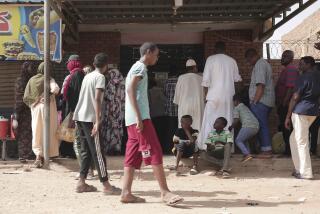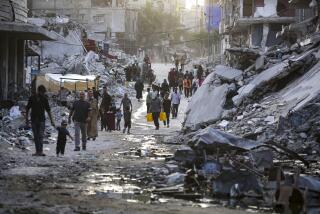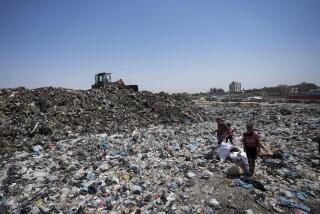Cholera outbreak pushes war-ravaged Yemen to the brink of catastrophe
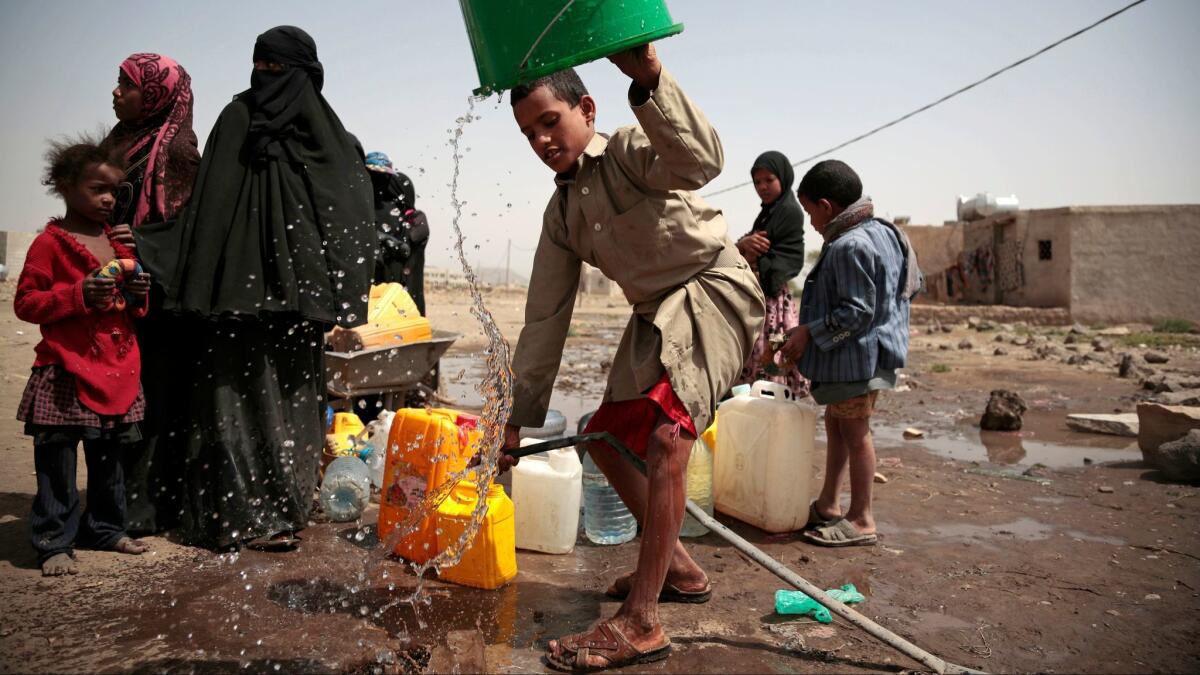
- Share via
A cholera outbreak in Yemen that has infected more than 300,000 people and caused more than 1,700 deaths in the last few months is propelling the war-ravaged nation to the brink of catastrophe, health and humanitarian officials say.
Security concerns amid a severe shortage of safe drinking water are limiting what can be done to help fight the often-fatal bacterial disease, which causes severe vomiting, diarrhea and dehydration.
The World Health Organization said this week issues related to security and other challenges caused it to suspend plans to deliver doses of the oral cholera vaccine to Yemen. In addition, officials said that because so much of the country has been exposed to the disease, providing clean water may be a more effective path to helping people.
The nation’s Ministry of Health, in consultation with the WHO and other partners, decided to focus less on vaccines and instead on helping people access clean water.
“The situation has evolved so rapidly that vaccines are not the priority tool to use now,” Fadela Chaib, a spokeswoman for the Geneva-based WHO said in an email Wednesday.
“The main challenge remains identifying and reaching the areas and the people where the cholera outbreak has not yet fully emerged,” she said. “Vaccinating during an ongoing outbreak is not advised.”
Chaib acknowledged that the “security, logistical and also political challenges are immense” but said that the destinations to which the vaccines might be rerouted were still under discussion.
The outbreak started last fall, accelerated in April, and in June, the WHO declared that Yemen was facing “the worst cholera outbreak in the world.”
The estimated 313,538 suspected cholera cases in the country means that 1 in 86 Yemenis is suspected of having the disease, said Iolanda Jaquemet, a spokeswoman for the Near East and Middle East regions at International Committee of the Red Cross.
In a typical cholera outbreak, about 20% of the cases would be considered severe, meaning they would need an aggressive medical response, Jacquemet said. In Yemen, 40% of cases are severe.
Cholera is endemic in Yemen, where there was an outbreak during the last six months of 2016. About 26,000 cases were reported and 112 people died, Jaquemet said.
“This is no comparison to the current situation,” she said.
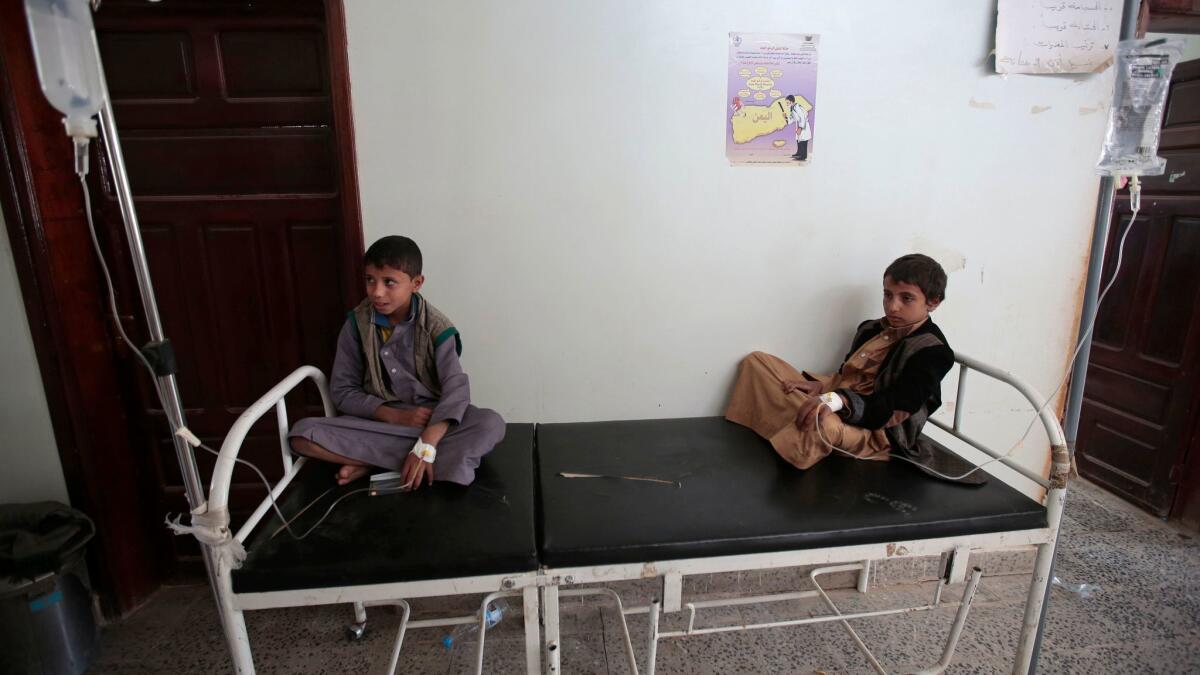
The humanitarian situation in Yemen was catastrophic even before the cholera outbreak.
“It’s basically a country that is devastated, that is being brought to its knees,” Jaquemet said.
Two years of conflict between pro-government forces and the predominantly Shiite Muslim Houthi rebels have laid the groundwork for unhealthy conditions, aid workers said.
Before the war, Yemen was already the poorest country in the Arab world. It relied on imports of food, medicine, fuel and aid to survive. With the war, less than half the imports are flowing in, including less than one-third of all medicines.
According to Jacquemet, civil servants including doctors in public hospitals and clinics and municipal workers charged with tasks such as trash disposal have not been paid since at least late last summer. Heaps of garbage cover streets.
Many shopkeepers have had to close their stores because of lack of business and farmers can’t till their field because of bombings. Only 45% of healthcare structures, such as pharmacies and hospitals, are still operational, aid workers said.
The International Committee of the Red Cross has documented at least 160 attacks against such structures. Electricity and fuel are scarce and, according to the United Nations, at least 16 million people do not have access to clean water.
“There has been basic collapse of infrastructure,” said Simon Cowie, Yemen country director for the International Medical Corps, a Los Angeles-based nonprofit humanitarian organization. “The needs are astronomical. Add cholera to this, and it’s dire.”
Cowie, who spoke via Skype from Sana, the Yemeni capital, described a landscape strewn with damaged buildings and destroyed bridges, and where airstrikes shattered the silence at night.
Out of Yemen’s population of 27 million people, up to 19 million are in need of some kind of humanitarian aid and up to 9 million depend on such assistance to survive, Jaquemet said, citing U.N. data.
“This is huge, this is massive,” she said. “You have one-third of the country that depends on humanitarian aid. You have hundreds of thousands of kids who are severely acutely malnourished. The country is edging closer to famine by the day.”
Chaib, the WHO official, said the organization would “continue to focus on good care for those who do fall ill.”
The WHO was focusing on setting up treatment centers and oral rehydration therapy corners, distributing oral rehydration solution, providing training to health workers and working with communities to help them understand how to prevent and respond to cholera, she said.
The Red Cross has shipped in massive quantities of chlorine, about 300 tons of intravenous fluids, antibiotics and oral rehydration kits. Red Cross engineers have been working to refurbish water systems in several cities.
The International Medical Corps is helping to truck water, distributing water purification tablets and has deployed a network of community health volunteers to help educate Yemenis about cholera, among other efforts.
“It’s because of the response of the international aid community inside Yemen that things are not worse than they already are, because the local health authorities are not in a position to face such a totally massive unprecedented outbreak,” Jaquemet said.
For more on global development news, see our Global Development Watch page, and follow me @AMSimmons1 on Twitter
More to Read
Sign up for Essential California
The most important California stories and recommendations in your inbox every morning.
You may occasionally receive promotional content from the Los Angeles Times.
